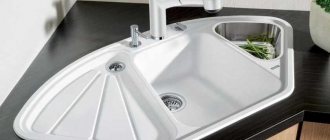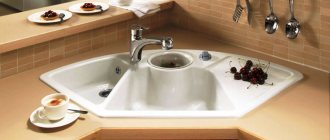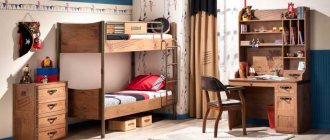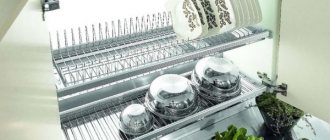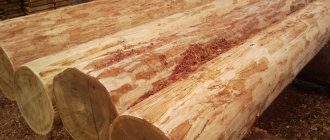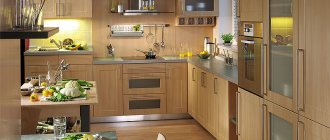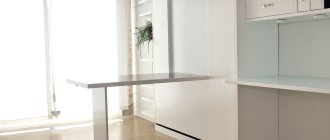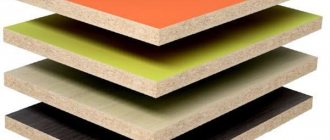Furniture
0
9 898
Share
The kitchen set plays an important role. It should be practical, inexpensive and beautiful. Today, headsets made from different materials are sold: chipboard, plastic, wood and MDF. But kitchen countertops made of MDF and chipboard are popular. These two materials are similar in appearance and manufacturing method. But what is better for the kitchen: MDF or chipboard? Let's try to figure it out.
- Chipboard: durability of the countertop
- Advantages and disadvantages of chipboard and laminated chipboard: which is better for the kitchen
- Finely dispersed fraction: the beauty of facades
- Conclusion: where to choose?
According to professionals, it is better to give preference to the fine dispersion fraction. This material is not so toxic, is stronger and looks much more attractive. But on this last point there is disagreement among people. Some believe that furniture made from laminated chipboard looks much more elegant than furniture made from finely dispersed fraction. What material to choose kitchen furniture from is up to the owner of the apartment to decide. But, undoubtedly, before choosing, you should know all the disadvantages and advantages of both materials.
Pros and cons of MDF
MDF (fine fraction) is wood dust boards pressed on an adhesive base.
This material is very practical and, at the same time, inexpensive. Painted MDF is much more expensive, but its price corresponds to the quality. The process of applying paint occurs in several layers, which are varnished at the end of the process. The customer can model the desired type of kitchen furniture, its shape and decide on color preference. MDF provides the opportunity to give furniture oval shapes and make sharp corners more rounded, thanks to various technologies. If you choose the painted MDF option, you can use any shade from a wide range of colors to personalize and brighten your kitchen furniture. A good option would be color synthesis.
MDF board
There are several types of MDF. The painted material is distinguished by its durability. It is resistant to any external damage: excessive humidity, large amounts of dirt, scratches. Frame MDF visually creates the appearance of using different types of wood. MDF with PVC elements will perfectly protect kitchen furniture from moisture and high temperatures.
Pros:
- regular MDF will be an excellent budget option;
- huge range of colors;
- relatively moisture-resistant material;
- any preferences in choosing a form are possible;
- the process of washing and wiping the surface occurs without problems;
- various coating options: varnish, matte, laminated, plastic;
- Perfect for long-term use.
Minuses:
- painted MDF is quite expensive;
- Any dirt or abrasions easily remain on the surface of this material;
- it quickly deteriorates from contact with high temperatures if covered with a film.
MDF has become a real breakthrough in the facade materials market. It is ideal for making kitchen furniture. MDF is an analogue of real wood, so you should not use dense materials to cover it. The most popular methods for finishing the surface of this material are PVC films and enamel.
Advice. In order for the MDF facade to last for a long time, it is better to cover it with plastic.
Cutting and edging laminated chipboard
When creating furniture, you can’t do without cutting the material. But in order for the product to turn out smooth, beautiful and without chips, certain experience and equipment are required. It is quite difficult to qualitatively cut a sheet of material at home due to its large size, but there are specialized stores and companies that cut laminated chipboard according to customer sizes.
Of course, it is difficult to cut a large sheet with a regular jigsaw, but using a machine is a completely different matter.
Cutting at home
It is possible to cut laminate flooring at home, but it is unlikely that you will be able to avoid chips, although it is possible to reduce their size and number. You can more or less efficiently cut laminated chipboard at home if:
- carry out cutting on a hard, flat surface (if you need to cut a large, solid sheet, you can adapt two tables of the same height for this);
- to avoid chipping, you need to stick masking or regular tape along the cut line;
- When cutting small parts, you can use a hacksaw with well-sharpened small teeth;
- when cutting with a jigsaw, you can scratch the cut line, going through the laminated layer;
- It is best to use files with fine teeth;
- when working with a jigsaw, you need to set the maximum speed and pendulum mode;
- The jigsaw must be pressed firmly against the surface of the sheet.
Small parts can also be cut with hand-held power tools.
These tips will help reduce the number of chips, but avoiding them completely and making a perfectly straight cut line will not be possible without special equipment that only specialized companies can afford.
Video: how to cut material without chipping
What is edging and why is it necessary?
Edging is the obligatory application of a protective strip made of various materials to the ends of parts. The edge performs several important functions:
- gives the material and the product itself a finished look;
- provides additional protection against moisture penetration into the middle of the part;
- prevents the release of formaldehyde and other resins contained in the binder component used in the production of laminated chipboards.
You can do the edging of chipboard with your own hands, or you can also order this operation from a specialized company that uses special edging machines for these purposes.
The edge can have different thicknesses and be made of different materials
For edging, paper (melamine) or PVC edges are used. At home, it is easier to work with a melamine strip that has an adhesive layer. The edge is applied to the end of the part, ironed with a hot iron or heated with an industrial hair dryer and rubbed in with a bar wrapped in felt or cloth. Carefully remove the protruding edges of the protective strip (so as not to accidentally cut off the laminated layer) using a shoe knife or the blunt side of the blade from a stationery cutter. After this, walk with a “zero” along the cut marks, also trying not to touch the laminating layer of the slab.
Sawing machine
Furniture companies mainly use PVC edges and manual finishing equipment (special milling cutters).
You can learn about the types of end edges from this video:
Programs for cutting laminated chipboards and online resources
After the furniture design has been developed, the dimensions of all the necessary elements have been calculated and detailed details have been drawn up, it is necessary to make a material cutting map. This is necessary for the optimal placement of all parts on the plate, facilitating the work of the sawyer and, most importantly, minimizing waste. If you order furniture from a company, then the designer knows perfectly well what to do and can easily cut laminated chipboard according to the customer’s size, but when everything is done at home yourself, you will need a special program.
This is what a cutting map made in Astra looks like
There are several popular programs for cutting sheet or roll materials - Basic-Furniture Maker, Astra, Cutting and others. All of these programs are paid, but you can also download “cracked” versions, although there is a big risk of getting a not very pleasant surprise on your computer, the elimination of which may cost more than the fee for purchasing licensed software. You should buy a license only if furniture production is a means of earning money for you, and for a single case you can do online cutting of chipboard on the Internet, since there are plenty of such resources.
Master-Basic makes cutting sheet materials easier and more accurate, reducing waste area
Now there are many specialized sites on the Internet where you can find drawings of any furniture with detailed detailing and a detailed description of the assembly process. There you can also find online calculators for cutting laminated chipboard.
By watching the video below you can get an idea of how a material cutting map is made:
Advantages of laminated chipboard
Chipboard - chipboard, replaced facades made of ordinary wood. This material has become a budget option for making kitchen furniture.
The basis of the material is dried shavings, pressed together with synthetic resins. For a better appearance, the chipboard is varnished, and the surface is covered with additional material that hides the unevenness remaining after sanding.
Laminated chipboard
Laminated chipboard is the cheapest option for making a facade. But, unfortunately, of poor quality. A kitchen facade made of this material will look cheap and unattractive. Laminated chipboard cannot be adjusted to the desired shape, since it is not flexible. Only simple designs can be made from it, which can hardly be called fashionable and easy to use.
Attention! LDPS must be covered with additional material. This will help hide unevenness and make the surface of the kitchen furniture usable.
Advantages:
- very cheap material;
- can be used as a temporary option.
Flaws:
- low quality;
- must be covered with additional material;
- simple and unattractive appearance;
- low heat and moisture resistance;
- requires constant care.
The main positive quality of laminated chipboard is its low cost. This material may not be the best option for making fashionable kitchen furniture. Moreover, it does not meet all standards of kitchen equipment. But LDPS will be an ideal temporary option for a kitchen facade or a new addition to a rented apartment.
Conclusion
So, answering the question “kitchen made of chipboard or MDF – which is better?”, we looked at the advantages and disadvantages of each material. Now we can easily draw the following conclusion: kitchen furniture made from MDF boards is much more environmentally friendly, more reliable and also more varied than furniture made from chipboard boards. But, alas, it will cost more (at least for the next six months).
Therefore, if you are for quality and durability, then do not skimp and buy kitchen furniture made from MDF - everything will pay you back twice as much. Well, if you are a little strapped for money, then choose the second option.
But here it is important to find out from the seller all the nuances (especially what class the material from which the product you like was made belongs to).
If you are still in doubt - chipboard or MDF kitchen - look at the thematic photos and video materials we have selected. We hope that after this you will make the final and optimal decision for you.
Read also the article about kitchen facades made of MDF.
Did you like the article? Subscribe to our Yandex.Zen channel
Great article 0
Advantages of plastic
Unlike MDF and laminated chipboard, plastic is not the basis for the manufacture of kitchen furniture, but its decorative coating. This is the best way to preserve the appearance of the facade. Thanks to this additional coating, kitchen furniture will last much longer and retain its appearance. Caring for a plastic surface does not present any difficulties: it can be easily cleaned with detergents without absorbing them, and is easily wiped off from dirt.
Furniture facades lined with plastic
Since plastic is only a coating, a base is used to make the kitchen facade. Such a basis can be a budget option - chipboard or a more expensive one - MDF. During processing of the base material, plastic is glued to its surface.
The plastic is based on ordinary paper, which allows you to combine different colors, designs, and create a unique product for further use. Color design will favorably emphasize the appearance of kitchen furniture and make it more visually attractive.
Advantages:
- durable to use;
- heat resistant;
- moisture-resistant material;
- large selection of colors and patterns;
- easy to clean, does not absorb heavy dirt;
- does not fade in the sun.
Thus, plastic will become the best material for additional coating. It is perfect for a long period of use and will be well preserved. Cleaning kitchen surfaces will become even easier, since the plastic is easy to wipe off and does not come into contact with detergents.
Material for kitchen facade
The following materials are used for the arrangement:
- laminated chipboard;
- MDF;
- tree;
- frame;
- aluminum profile.
If everything is clear with wood or aluminum, then the abbreviations LDSP and MDF raise questions for many. These materials are widely used in modern furniture production.
The creation of materials such as laminated chipboard and MDF makes it possible to develop a wide range of products for the home, including the kitchen. Which is better: MDF or chipboard?
The kitchen needs furniture to withstand temperature fluctuations and high humidity. Cabinet doors are constantly subject to mechanical stress; they are opened with wet hands. Therefore, the façade of a kitchen unit is usually made of MDF, and the side walls and shelves are made of laminated chipboard. This is due to the characteristics of the materials.
What material is better to use?
The answer to this question depends on several factors.
Firstly, the price characteristic. If kitchen furniture should become a regular budget option, you should use laminated chipboard. MDF is a much better option, but accordingly it costs more. It resembles natural wood and is of higher quality.
Painted MDF furniture facades
Secondly, surface treatment. Chipboard is initially treated with varnish, but the coating must be finished with plastic. With the help of finishing material, the top ball of the kitchen facade will become smooth and suitable for use. The surface of MDF can be treated with enamel or PVC film. This will improve the appearance of the facade and make it smoother. In order to extend the life of the facade, it is better to treat it with additional material – plastic.
Thirdly, the shelf life. If kitchen furniture is made for a long period, you should spare no expense and choose MDF. Laminated chipboard is perfect only as a temporary option.
Fourthly, design. If you plan to make kitchen furniture in a fashionable style with round corners and additional design options, MDF will be the only option.
Finding the right material for making kitchen furniture is very difficult. It all depends on the price characteristics, duration of operation, appearance and design. The market offers a wide selection of raw materials for kitchen facades, but the best option is plastic-coated MDF. It includes all the necessary qualities to produce perfect kitchen furniture.
What to choose for the kitchen - MDF or chipboard?
All quality and performance characteristics speak in favor of MDF. It is safe for humans, durable, has an attractive appearance, and makes it possible to give the kitchen a unique look. This material embodies practicality and quality, but will also cost a decent amount.
Laminated chipboard will be an ideal choice when buying expensive furniture for the kitchen is not a priority for the near future. The main thing when making a purchase is to make sure that the facades are made on the basis of chipboard with a minimum content of formaldehyde.
Material for kitchen furniture: photo
Features of MDF countertops
- Resistant to high temperatures - you can place a pot of boiling water on them.
- When exposed to light, the color of the surface does not change.
- Furniture on which the film is correctly installed does not absorb water vapor and water, and the material does not delaminate over time.
- Resistant to mild household detergents, as well as stains from milk, coffee, tea, wine - they are not absorbed due to lamination.
- Quite resistant to scratches and dents.
- May fade due to direct exposure to steam.
These features relate to the working surface of the tabletop. You should know that if you install appliances under the countertops, sheet metal or plastic must be additionally secured to the underside, which will create additional strengthening of the structure.
Choosing the optimal countertop
In order for the chosen countertop for the kitchen to delight the inhabitants of the apartment for many years, it must meet the following basic requirements:
- aesthetics, sophistication and compliance with the overall interior of the room;
- compatibility with the area of the room, as well as furniture and apron;
- strength and reliability, guaranteeing the use of the product for many years;
- practicality, allowing you to easily wash the kitchen countertop;
- moderation in price;
- resistance to water, moisture, food and cleaning agents;
- compliance with the preferences and requirements of the inhabitants of the apartment or house.
The surface of the kitchen countertop can be glossy or matte. But the matte version is considered more durable, although it is not as beautiful and bright.
In addition, it is important to choose the correct size of the product. Manufacturers make kitchen countertops in several sizes. Thus, the usual slab thickness is 28 mm, but surfaces with a thickness of 26 and 38 mm are also popular. The width of such products can be 600, 900 or even 1200 mm, and the length can be 3050 mm. However, if you wish, you can always order an individual production of a kitchen countertop with the most suitable parameters, although this will require large expenses.
Thus, laminated chipboard differs from chipboard only in the additional layer of paper plastic. It is the top protective layer that makes the laminated board more reliable and durable. Therefore, if the apartment owner is primarily interested in the quality of the kitchen countertop, then he should choose laminated chipboard. If the lower cost of the material is of fundamental importance, then it is better to choose chipboard, which also has many advantages.
